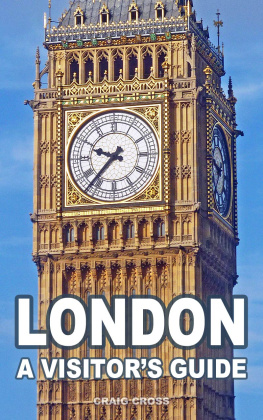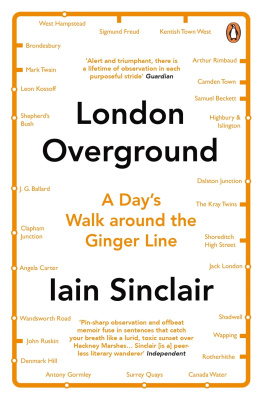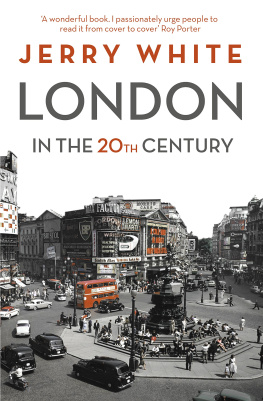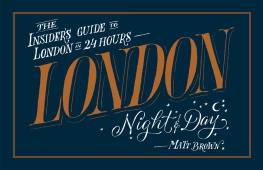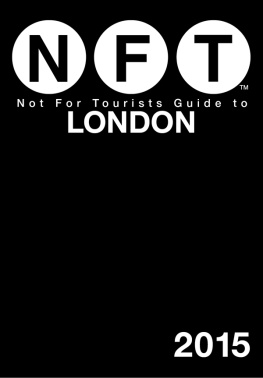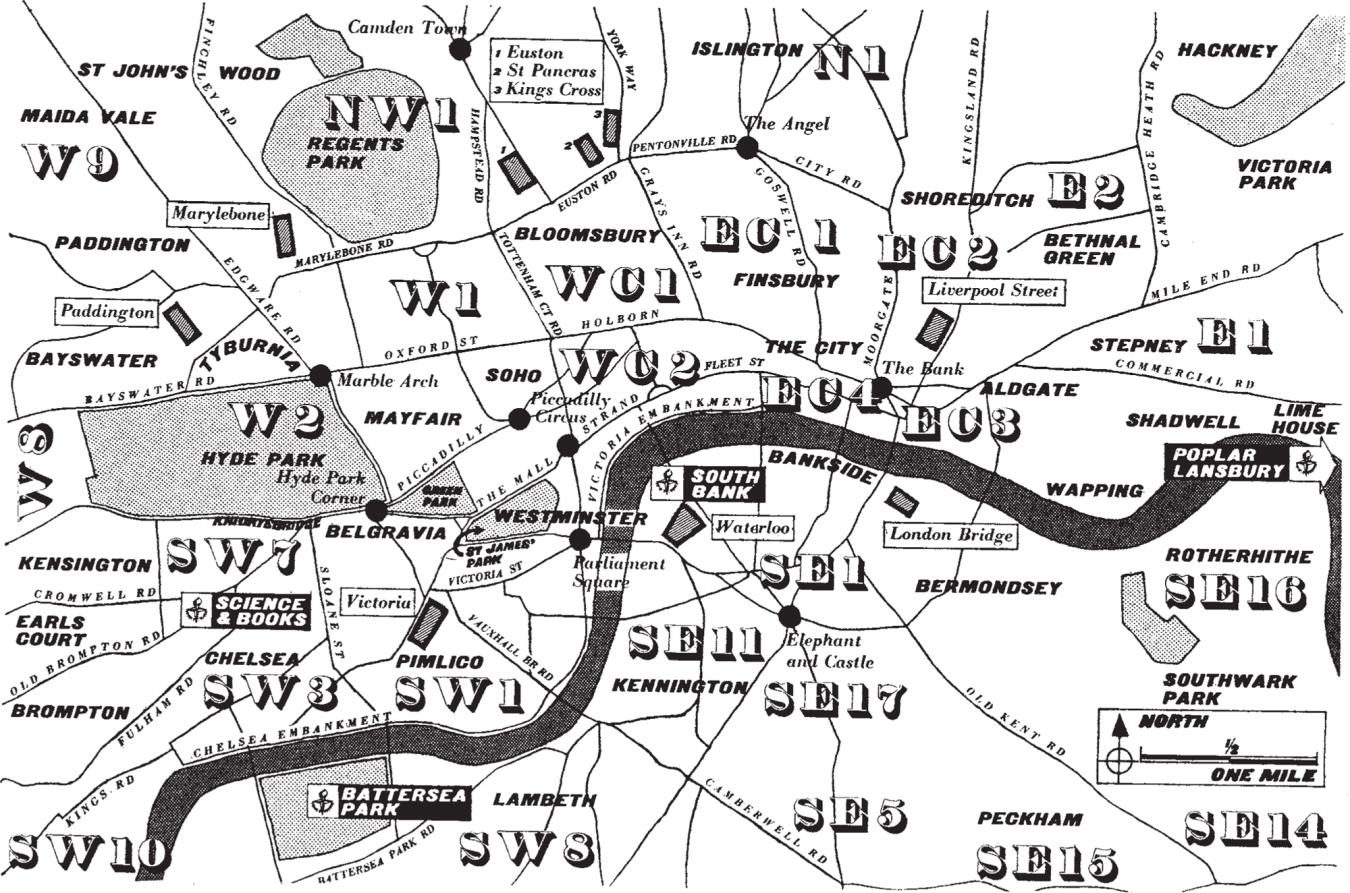LONDON
NIGHT AND DAY
illustrated by
OSBERT LANCASTER
a guide to where the other books dont take you
EDITED BY SAM LAMBERT
CONTENTS
MAPS
Alas, theres room in this guide for only one small map, so charactered as to give you a general idea (were sorry its no more) where the street you want to find is. Reference is from the postal area given in the address, to the postal area shown on the map (W.C.1, E.C.15, etc.). The rest of the work youll have to do yourself from other maps or helpful policemen. Were sorry about this, but to give a really efficient map service for the sort of out-of-the-way things we direct you to, would require another book of maps the size of this, an unnecessary duplication, since good ones exist already. What we have done is to suggest maps and where to get them under the Maps and Guidebooks heading of SHOPPING (9 a.m.).
IMPORTANT NOTE
In the pages which follow we distribute praise and blame with God-like indiscretion. It is important that you, the reader, should understand that these opinions are, so far as human opinions may be, entirely disinterested. This is a personal guide, coloured in no way whatsoever by demand of advertising (there isnt any) or by hidden payments (none). No opinion, no phrase, no word has been prompted by any kind of gainful motive or commercial pressure. Please take it from us that the things we say about London, its people, trades, pleasures, licit and illicit, are said because we believe them to be true. Naturally, as with all guide books, items become dated, opening times change, prices go up (so rarely come down). We would seriously ask you to keep us up to date. Advice or information from any source including shopkeepers and restaurateurs will be warmly welcomed. Write to Sam Lambert, London Night and Day, 9-13, Queen Annes Gate, S.W.1.
Mrs Gould and Mr Douglas and I went in the Colonels chariot to the Haymarket. As we drove along and spoke good English, I was full of rich imagination of London, ideas suggested by the Spectator and such as I could not explain to most people, but which I strongly feel and am ravished with. My blood glows and my mind is agitated with felicity.
Boswells London Journal, 8 January 1763 (Heinemann, 21 s.)
LONDON
Unless you are a professional Bohemian, no capital city is cheap to stay in. London is not an exception, and if you are going places, you wont do it on air. Therefore in this guide we do not concentrate on what things would cost though we mention cost where we can; you will probably decide anyway that things cost plenty. We concentrate not on what London can get out of you but on what you can get out of London. Remembering that despite austerity and war, London is still the greatest market there is anywhere for goods of a quality and craftsmanship that the world wants and cant otherwise get.
Let us warn you right at the start, London is a misleading city. Except to the trained romantic its surface appearances are banal; and unlike Paris, whose charms are discernible when first you drive along the main thoroughfares, its main thoroughfares are far the most hideous part of it. Its charms are hidden round the corner and only to be enjoyed by those who seek them out. One purpose of this guide is to help those who seek them out to find them. Above the surface, with its incorruptible police and oh-so-practical local authorities, who care so much about the letterdrains and fire protectionand so little about the spirit of the law, London is a machine for doing business in, for getting workers to work in.
Beneath the surface London is the worlds greatest man-hive, not merely in numbers of citizens (a meaningless criterion) but in variety of actionthe Athens, New York, Washington, Monte Carlo, Singapore, Hollywood, Forest Hills, Ancient Rome of about a quarter of the Earths inhabitants. Thus if you walk down Bond Street it is a good bet that you will be, at sometime or other, within a few yards of an international crook, a ditto financier, a literary genius, a sea-captain, a King, a femme fatale, a famous athlete, a Royal couturier, a Scottish laird, an English duchess, a great painter, an empire builder, a spy, a sultan, a field-marshal or a legislator. London is the worlds greatest get-together, not so much of types, classes, races, as of individual departures from the norm. And if you take the trouble to peer beyond the fronts of the great shopping streets into the almost secret places behindthe Georgian alleys, the intimate pubs, the little markets, the masked mews, the squares filled with great trees, the hidden yards covered in cobbles; or, better still, penetrate into the cosy clubs, grand salons, panelled chambers, bar parlours, that lie behind these facades, you will begin to discover the London that hypnotised Boswell and Dickens. A London that built and backed the Commonwealth; a London of significant individuals leading a vast variety of individual lives, in a vast variety of individual ways, heroic and unheroic, major and minor, savoury and unsavoury, legal and illegalyet achieving despite that individualism a certain community, even strength, of purpose. And still, despite blitzes and convulsions, strong in its original virtue of non-conformity.
The 20th century, in trying to conveyor-belt us all, has made a big effort to standardise London. But the essential London is only half standardised, and may beat the conveyor-belt yet. If you have eyes to see and a soul to love it, that other unstandardised half is still there for the finding. Our job in this guide is to help you, the visitor, to find it. Forgive us if we credit you with ignorance you are far from having. Obviously we have to write for those who dont know the answers. Obviously, on the other hand, there is a limit in terms of grape-vine to what the printed, as opposed to the whispered, word can achieve. Within these limitations we try, in what follows, to break through the surface generalisations of the standardised guide books to that living tissue of skills, specialisations, appetites, graces, eccentricities and solicitudes, that have made London the place it is, so that you in your turn, dear visitor, may learn how to break into a ducal home, a murder trial, Savile Row, a theatre-club, the House of Commons, a nightclub. So that you may know at last where to get the best glass eye, riding boots, moussaka, glimpse of the 18th century, riverside pub, jazz, coffee; even so that you may know where to pawn your watch. Our motto for the visitor to London islook beneath the surface. And in the pages which follow Osbert Lancaster, the doyen of London nonconformity, supports our stream of good advice with drawings that eloquently evoke Londons other under-surface look.

7 am
HOW IT BEGAN
First thing to understand clearly is that where there are no roads, rivers act as highways. Always have, always will. Hence in pre-Roman days the big river so close to the mainland of Europe (swampy and forested but with gravel patches, useful sites for bridges or fords), became the natural entry into Britain for all the adventurers who were out to exploit this little-known island, mild of climate, fertile of soil, and good for oysters, pearls, hunting dogs, tin and gold.
first Londoners


